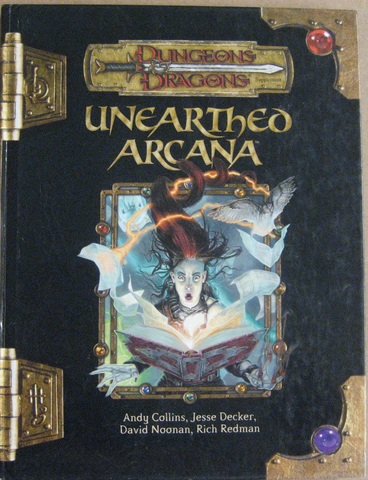The 3rd ed. Unearthed
Arcana is my favorite d20 product that I almost never use. While it
probably doesn’t have many fond memories amongst the OSR, I consider it to be a
prime example of the old school tendencies of 3rd edition. When 4e
tried to do anything ‘old school’ it often came off horribly misguided (transforming
the Crystal Caves into a lazy encounters sequence, for instance). But what d20
had going for it was modularity, the same kind that (I hope) will categorize
the new edition. The designers of 3e often used the d20 system as an umbrella
to cover many variant subsystems like the Book
of Nine Swords, Magic of Incarnum,
Psionics, and wildly different takes on races and classes.
Unearthed Arcana
was what the DMG of 3rd should have been: rather than just a list of
rules that covered the ‘behind the scenes’ of combat and treasure and whatnot,
you got an enormous number of variations on the given systems. Now, many of
these sucked, but that’s besides the point. How about a Savage Bard or an Urban
Ranger? Want to play an Earth Kobold? How about a Githyanki-blooded human? Want
to throw out the classes and go Generic? Spell-Points? Variable attack
modifiers? There were even rules for replacing d20 rolls with d6s! While many
of these things didn’t work out, they were all about expanding your idea of
what could be done with the game.
When confronting the issue of a fifth edition, the question
at this point for D&Ders is, ‘What do we need from a new edition?’ What
could we get from 5th edition that we couldn’t hack out of 4th,
3rd, 2nd, 1st, Basic or Original? What could
we produce aside from another unique variation on common themes, and why would
we need that from a professional company rather than an independent one, or a
single designer? I for one might be interested in a pure ‘Mearls D&D’ or
‘Monte Cook Basic’, but I don’t know why I would want to deal with corporate
agendas alongside game creativity.
If D&D Next is going to have any real impact, it will
not be mechanically. If they stick to modularity, multiple subsystems, the OGL,
and variation there will be much for us to draw on. But the most important
contribution will not be in the core engine. It will come from the attitude of
the new edition. I have meditated much on James’ idea that D&D is a goulash.
As Jeff says, you play Gandalf, I play Conan, we team up to fight Dracula. This
is why I love Eberron and Dark Sun, both goulashes of more specific sets of influences.
4e didn’t suit me because it is about balance, tactical play and ‘heroes’,
entirely existing in a self-referential ouroboros. If the new version of
D&D will succeed, it will be because it allows for weirdness, variation,
giant space hamsters and Victorian plane-hoppers. It will allow for laser guns
and medusa escort services. It will rip off everything that comes in its path,
and glory in it. It will become D&D by striving to be whatever it wants.


